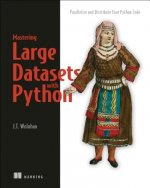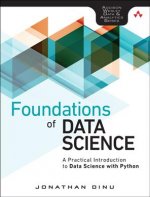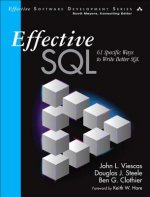
Code: 04834883
Synopses for Massive Data
by Graham Cormode, Minos Garofalakis, Peter J. Haas
Synopses for Massive Data: Samples, Histograms, Wavelets, Sketches describes basic principles and recent developments in building approximate synopses (i.e., lossy, compressed representations) of massive data. Such synopses enable ... more
- Language:
 English
English - Binding: Paperback
- Number of pages: 308
Publisher: Now Publishers Inc, 2011
- More about this

You might also like
-

Using Informational Text to Teach To Kill A Mockingbird
64.87 € -

Role of Regions and Sub-National Actors in Europe
159.44 € -

Women's Entrepreneurship in the 21st Century - An International Multi-Level Research Analysis
146.32 € -10 % -

Nutrition and Health
25.11 € -19 % -

Bass Player's Guide To Jamming
30.29 € -

Long Day's Journey into Night
6.50 € -12 % -

Weihnachten in Wichtelhausen, 1 Audio-CD
14.02 € -4 %
Give this book as a present today
- Order book and choose Gift Order.
- We will send you book gift voucher at once. You can give it out to anyone.
- Book will be send to donee, nothing more to care about.
More about Synopses for Massive Data
You get 254 loyalty points
 Book synopsis
Book synopsis
Synopses for Massive Data: Samples, Histograms, Wavelets, Sketches describes basic principles and recent developments in building approximate synopses (i.e., lossy, compressed representations) of massive data. Such synopses enable approximate query processing, in which the user's query is executed against the synopsis instead of the original data. The monograph focuses on the four main families of synopses: random samples, histograms, wavelets, and sketches. A random sample comprises a "representative" subset of the data values of interest, obtained via a stochastic mechanism. Samples can be quick to obtain, and can be used to approximately answer a wide range of queries. A histogram summarizes a data set by grouping the data values into subsets, or "buckets," and then, for each bucket, computing a small set of summary statistics that can be used to approximately reconstruct the data in the bucket. Histograms have been extensively studied and have been incorporated into the query optimizers of virtually all commercial relational DBMSs. Wavelet-based synopses were originally developed in the context of image and signal processing. The data set is viewed as a set of M elements in a vector - i.e., as a function defined on the set {0, 1, 2, ..., M-1} - and the wavelet transform of this function is found as a weighted sum of wavelet "basis functions." The weights, or coefficients, can then be "thresholded", for example, by eliminating coefficients that are close to zero in magnitude. The remaining small set of coefficients serves as the synopsis. Wavelets are good at capturing features of the data set at various scales. Sketch summaries are particularly well suited to streaming data. Linear sketches, for example, view a numerical data set as a vector or matrix, and multiply the data by a fixed matrix. Such sketches are massively parallelizable. They can accommodate streams of transactions in which data is both inserted and removed. Sketches have also been used successfully to estimate the answer to COUNT DISTINCT queries, a notoriously hard problem. Synopses for Massive Data describes and compares the different synopsis methods. It also discusses the use of AQP within research systems, and discusses challenges and future directions. It is essential reading for anyone working with, or doing research on massive data.
 Book details
Book details
Book category Books in English Computing & information technology Computer programming / software development Database programming
101.98 €
- Full title: Synopses for Massive Data
- Author: Graham Cormode, Minos Garofalakis, Peter J. Haas
- Language:
 English
English - Binding: Paperback
- Number of pages: 308
- EAN: 9781601985163
- ISBN: 1601985169
- ID: 04834883
- Publisher: Now Publishers Inc
- Weight: 452 g
- Dimensions: 234 × 156 × 17 mm
- Date of publishing: 30. December 2011
Trending among others
-

Beginning PL/SQL
37.11 € -19 % -

SQL Cookbook
49.92 € -24 % -

Oracle PL/SQL Best Practices 2e
25.82 € -17 % -

Getting Started with SQL
34.26 € -2 % -

Pro T-SQL Programmer's Guide
111.13 € -

Murachs Oracle SQL & Pl / SQL for Developers
44.73 € -18 % -

Geoprocessing with Python
56.53 € -

Oracle PL/SQL For Dummies
26.73 € -19 % -

Oracle Database 12c PL/SQL Advanced Programming Techniques
66.70 € -27 % -

Joe Celko's SQL for Smarties
81.04 € -

Head First SQL
45.65 € -24 % -

SQL Tuning
32.43 € -20 % -

NoSQL For Dummies
25.51 € -29 % -

Oracle Database 11g PL/SQL Programming
65.07 € -18 % -

Pro LINQ in VB8
37.11 € -19 % -

Formal SQL Tuning for Oracle Databases
61.31 € -

Real World SQL and PL/SQL: Advice from the Experts
59.48 € -19 % -

Practical Database Programming With Visual C#.NET
137.98 € -

SQL Queries for Mere Mortals
40.26 € -9 % -

Guerrilla Analytics
56.32 € -

Microsoft SQL Server 2016 Reporting Services, Fifth Edition
53.88 € -19 % -

Joe Celko's Trees and Hierarchies in SQL for Smarties
36.09 € -14 % -

Microsoft SQL Server 2005 Stored Procedure Programming in T-SQL & .NET
61.92 € -18 % -

Pro SQL Server Always On Availability Groups
100.25 € -

SQL in Easy Steps
14.33 € -9 % -

Mastering Large Datasets
56.43 € -

Essential SQLAlchemy, 2e
44.12 € -

Art of SQL
44.12 € -20 % -

Learning SQL
40.26 € -20 % -

SQL Server Query Performance Tuning Distilled
49.11 € -18 % -

Pro SQL Server Reporting Services
33.14 € -18 % -

Transact-SQL Cookbook
44.12 € -

Oracle PL/SQL
84.39 € -4 % -

Foundations of Data Science
42.09 € -9 % -

SQL Bible 2e
49.11 € -19 % -

Pro Tableau
69.04 € -19 % -

SQL: A Beginner's Guide
30.70 € -19 % -

Effective SQL
51.55 € -

Expert PHP and MySQL
61.92 € -

Pervasive Computing
159.44 € -

Modern B-Tree Techniques
101.98 € -

MongoDB Recipes
37.11 € -19 % -

Extending SSIS with .NET Scripting
100.25 € -

SQL Primer
45.14 € -18 % -

Big Data Analytics and Knowledge Discovery
61.92 € -

DevOps, DBAs, and DBaaS
67.41 € -

Oracle PL/SQL for DBAs
36.29 € -21 % -

Joe Celko's Analytics and OLAP in SQL
68.43 € -

Dissecting SQL Server Execution Plans
25.11 € -19 %
Collection points Bratislava a 2642 dalších
Copyright ©2008-24 najlacnejsie-knihy.sk All rights reservedPrivacyCookies



 15549 collection points
15549 collection points Delivery 2.99 €
Delivery 2.99 € 02/210 210 99 (8-15.30h)
02/210 210 99 (8-15.30h)